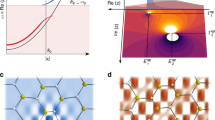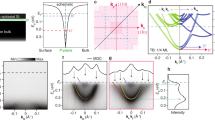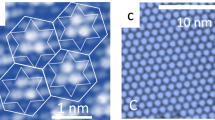Abstract
Dopant atoms are used to control the properties of semiconductors in most electronic devices. Recent advances such as single-ion implantation1,2,3,4,5 have allowed the precise positioning of single dopants in semiconductors as well as the fabrication of single-atom transistors6,7,8,9, representing steps forward in the realization of quantum circuits10,11,12,13,14. However, the interactions between dopant atoms have only been studied in systems containing large numbers of dopants, so it has not been possible to explore fundamental phenomena such as the Anderson–Mott transition between conduction by sequential tunnelling through isolated dopant atoms, and conduction through thermally activated impurity Hubbard bands15,16,17,18. Here, we observe the Anderson–Mott transition at low temperatures in silicon transistors containing arrays of two, four or six arsenic dopant atoms that have been deterministically implanted along the channel of the device. The transition is induced by controlling the spacing between dopant atoms. Furthermore, at the critical density between tunnelling and band transport regimes, we are able to change the phase of the electron system from a frozen Wigner-like phase to a Fermi glass by increasing the temperature. Our results open up new approaches for the investigation of coherent transport, band engineering and strongly correlated systems in condensed-matter physics.
This is a preview of subscription content, access via your institution
Access options
Subscribe to this journal
Receive 12 print issues and online access
$259.00 per year
only $21.58 per issue
Buy this article
- Purchase on Springer Link
- Instant access to full article PDF
Prices may be subject to local taxes which are calculated during checkout



Similar content being viewed by others
References
Shinada, T., Okamoto, S., Kobayashi, T. & Ohdomari, I. Enhancing semiconductor device performance using ordered dopant arrays. Nature 437, 1128–1131 (2005).
Tan, K. Y. et al. Transport spectroscopy of single phosphorus donors in a silicon nanoscale transistor. Nano Lett. 10, 11–15 (2010).
Persaud, A. et al. Integration of scanning probes and ion beams. Nano Lett. 5, 1087–1091 (2005).
Shinada, T. et al. A reliable method for the counting and control of single ions for single-dopant controlled devices. Nanotechnology 19, 345202 (2008).
Hori, M. et al. Enhancing single-ion detection efficiency by applying substrate bias voltage for deterministic single-ion doping. Appl. Phys. Exp. 4, 046501 (2011).
Koenraad, P. M. & Flatté, M. E. Single dopants in semiconductors. Nature Mater. 10, 91–100 (2011).
Pierre, M. et al. Single-donor ionization energies in a nanoscale CMOS channel. Nature Nanotech. 5, 133–137 (2010).
Morello, A. et al. Single-shot readout of an electron spin in silicon. Nature 467, 687–691 (2010).
Fuechsle, M. et al. A single atom transistor. Nature Nanotech. 7, 242–246 (2012).
Hollemberg, L. C. L., Greentree, A. D., Fowler, A. G. & Wellard, C. J. Two-dimensional architectures for donor-based quantum computing. Phys. Rev. B 74, 045311 (2006).
Rahman, R. et al. Atomistic simulations of adiabatic coherent electron transport in triple donor systems. Phys. Rev. B 80, 035302 (2009).
Prati, E. Valley blockade quantum switching in silicon nanostructures. J. Nanosci. Nanotech. 11, 8522–8526 (2011).
Leti, G. et al. Switching quantum transport in a three donors silicon fin-field effect transistor. Appl. Phys. Lett. 99, 242102 (2011).
Klein, M. et al. Ternary logic implemented on a single dopant atom field effect silicon transistor. Appl. Phys. Lett. 96, 043107 (2010).
Anderson, P. W. Absence of diffusion in certain random lattices. Phys. Rev. 109, 1492–1505 (1958).
Mott, N. F. & Twose, W. D. The theory of impurity conduction. Adv. Phys. 10, 107–163 (1961).
Mott, N. F. Metal–Insulator Transitions (Taylor and Francis, 1974).
Hubbard, J. Electron correlations in narrow energy bands. Proc. R. Soc. Lond. A 276, 238–257 (1963).
Ono, Y. et al. Conductance modulation by individual acceptors in Si nanoscale field-effect transistors. Appl. Phys. Lett. 90, 102106 (2007).
Lansbergen, G. P. et al. Gate-induced quantum-confinement transition of a single dopant atom in a silicon FinFET. Nature Phys. 4, 656–661 (2008).
Prati, E., Latempa, R. & Fanciulli, M. Microwave-assisted transport in a single-donor silicon quantum dot. Phys. Rev. B 80, 165331 (2009).
Prati, E. et al. Adiabatic charge control in a single donor silicon quantum dot. Appl. Phys. Lett. 98, 053109 (2011).
Mazzeo, G. et al. Charge dynamics of a single donor coupled to a few electrons quantum dot in silicon. Appl. Phys. Lett. 100, 213107 (2012).
Thomas, G. A., Capizzi, M., DeRosa, F., Bhatt, R. N. & Rice, M. T. Optical study of interacting donors in semiconductors. Phys. Rev. B 23, 5472–5494 (1981).
Sellier, H. et al. Transport spectroscopy of a single dopant in a gated silicon nanowire. Phys. Rev. Lett. 97, 206805 (2006).
Beenakker, C. W. J. Theory of Coulomb-blockade oscillations in the conductance of a quantum dot. Phys. Rev. B 44, 1646–1656 (1991).
Norton, P. Formation of the upper Hubbard band from negative-donor-ion states in silicon. Phys. Rev. Lett. 37, 164–168 (1976).
Steele, G. A., Gotz, G. & Kouwenhoven, L. P. Tunable few-electron double quantum dots and Klein tunnelling in ultraclean carbon nanotubes. Nature Nanotech. 4, 363–367 (2009).
Podor, B. et al. Wigner crystal and other insulating phases of two-dimensional electrons in high magnetic fields, Opto-Electron. Rev. 9, 195–202 (2001).
Moraru, D. et al. Atom devices based on single dopants in silicon nanostructures. Nano Res. Lett. 6, 479 (2011).
Moraru, D., Kuzuya, Y., Mizuno, T., Tabe, M. & Mizuta, H. in Autumn JSAP symposium ‘Deterministic doping and single dopant devices for extended CMOS’, August 2011, Yamagata, Japan.
Mizuta, H., Kuzuya, Y., Moraru, D., Mizuno, T. & Tabe, M. in Italy–Japan Workshop on Single Atom Control for Future Nanoelectronics, November 2011, Tokyo, Japan.
Acknowledgements
This work was supported by SRC no. 1676.001, a Grant-in-Aid for Scientific Research (nos 22681020, 23226009 and 20241036) from MEXT, Japan, the PEST 2010-2012 Ministero Affari Esteri (MAE), Italy, and the Short-Term Mobility Program 2011, Consiglio Nazionale delle Ricerche (CNR), Italy.
Author information
Authors and Affiliations
Contributions
E.P. and F.G. carried out the measurements. M.H. and T.S. implanted the single donors. E.P., F.G. and G.F. analysed the data. E.P and T.S. designed the samples, the experiment and co-wrote the manuscript. All authors discussed the results and commented on the manuscript.
Corresponding authors
Ethics declarations
Competing interests
The authors declare no competing financial interests.
Supplementary information
Supplementary information
Supplementary information (PDF 1398 kb)
Rights and permissions
About this article
Cite this article
Prati, E., Hori, M., Guagliardo, F. et al. Anderson–Mott transition in arrays of a few dopant atoms in a silicon transistor. Nature Nanotech 7, 443–447 (2012). https://doi.org/10.1038/nnano.2012.94
Received:
Accepted:
Published:
Issue Date:
DOI: https://doi.org/10.1038/nnano.2012.94
This article is cited by
-
Anderson transition in stoichiometric Fe2VAl: high thermoelectric performance from impurity bands
Nature Communications (2022)
-
Experimental realization of an extended Fermi-Hubbard model using a 2D lattice of dopant-based quantum dots
Nature Communications (2022)
-
Rethinking radiation effects in materials science using the plasma-focused ion beam
Journal of Materials Science (2022)
-
Coherent transport of quantum states by deep reinforcement learning
Communications Physics (2019)
-
Adequacy of Si:P chains as Fermi–Hubbard simulators
npj Quantum Information (2018)



